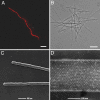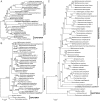A korarchaeal genome reveals insights into the evolution of the Archaea - PubMed (original) (raw)
. 2008 Jun 10;105(23):8102-7.
doi: 10.1073/pnas.0801980105. Epub 2008 Jun 5.
Mircea Podar, David E Graham, Kira S Makarova, Yuri Wolf, Lennart Randau, Brian P Hedlund, Céline Brochier-Armanet, Victor Kunin, Iain Anderson, Alla Lapidus, Eugene Goltsman, Kerrie Barry, Eugene V Koonin, Phil Hugenholtz, Nikos Kyrpides, Gerhard Wanner, Paul Richardson, Martin Keller, Karl O Stetter
Affiliations
- PMID: 18535141
- PMCID: PMC2430366
- DOI: 10.1073/pnas.0801980105
A korarchaeal genome reveals insights into the evolution of the Archaea
James G Elkins et al. Proc Natl Acad Sci U S A. 2008.
Abstract
The candidate division Korarchaeota comprises a group of uncultivated microorganisms that, by their small subunit rRNA phylogeny, may have diverged early from the major archaeal phyla Crenarchaeota and Euryarchaeota. Here, we report the initial characterization of a member of the Korarchaeota with the proposed name, "Candidatus Korarchaeum cryptofilum," which exhibits an ultrathin filamentous morphology. To investigate possible ancestral relationships between deep-branching Korarchaeota and other phyla, we used whole-genome shotgun sequencing to construct a complete composite korarchaeal genome from enriched cells. The genome was assembled into a single contig 1.59 Mb in length with a G + C content of 49%. Of the 1,617 predicted protein-coding genes, 1,382 (85%) could be assigned to a revised set of archaeal Clusters of Orthologous Groups (COGs). The predicted gene functions suggest that the organism relies on a simple mode of peptide fermentation for carbon and energy and lacks the ability to synthesize de novo purines, CoA, and several other cofactors. Phylogenetic analyses based on conserved single genes and concatenated protein sequences positioned the korarchaeote as a deep archaeal lineage with an apparent affinity to the Crenarchaeota. However, the predicted gene content revealed that several conserved cellular systems, such as cell division, DNA replication, and tRNA maturation, resemble the counterparts in the Euryarchaeota. In light of the known composition of archaeal genomes, the Korarchaeota might have retained a set of cellular features that represents the ancestral archaeal form.
Conflict of interest statement
The authors declare no conflict of interest.
Figures
Fig. 1.
Microscopy of Ca. K. cryptofilum. (A) FISH analysis with _Korarchaeota_-specific Cy3-labeled oligonucleotide probes KR515R/KR565R. The undulated cell shape results from drying of the specimen on gelatin coated slides before hybridization. (Scale bar, 5 μm.) (B) Phase-contrast image of korarchaeal filaments after physical enrichment. (Scale bar, 5 μm.) (C) Scanning electron micrograph of purified cells. (D) Transmission electron micrograph after negative staining with uranyl acetate displaying the paracrystalline S layer. Cells are flattened, which increases their apparent thickness.
Fig. 2.
Phylogenetic analysis of Ca. K cryptofilum. (A) Maximum-likelihood phylogenetic tree of combined (SSU + LSU) rRNAs rooted with corresponding bacterial sequences. Numbers at the nodes indicate bootstrap support. (B) Archaeal phylogeny based on translation EF2 proteins rooted with bacterial homologs. The numbers indicate bootstrap support for PhyML/consensus posterior probability (Phyloblast), an asterisk indicates <50 support. Where both values were <50, the branch was collapsed. Also see
Fig. S6
. (C) Maximum-likelihood tree made from aligned sequences of 33 universally conserved ribosomal proteins and the three largest RNA polymerase subunits, RpoA, RpoB, and RpoD. Bootstrap support numbers are given at the nodes as a percentage (n = 10,000). (Scale bars represent the average number of substitutions per residue.)
Comment in
- A Korarchaeote yields to genome sequencing.
Nealson K. Nealson K. Proc Natl Acad Sci U S A. 2008 Jul 1;105(26):8805-6. doi: 10.1073/pnas.0804670105. Epub 2008 Jun 24. Proc Natl Acad Sci U S A. 2008. PMID: 18577584 Free PMC article. No abstract available.
Similar articles
- Orthologs of the small RPB8 subunit of the eukaryotic RNA polymerases are conserved in hyperthermophilic Crenarchaeota and "Korarchaeota".
Koonin EV, Makarova KS, Elkins JG. Koonin EV, et al. Biol Direct. 2007 Dec 14;2:38. doi: 10.1186/1745-6150-2-38. Biol Direct. 2007. PMID: 18081935 Free PMC article. - Insights into the evolution of Archaea and eukaryotic protein modifier systems revealed by the genome of a novel archaeal group.
Nunoura T, Takaki Y, Kakuta J, Nishi S, Sugahara J, Kazama H, Chee GJ, Hattori M, Kanai A, Atomi H, Takai K, Takami H. Nunoura T, et al. Nucleic Acids Res. 2011 Apr;39(8):3204-23. doi: 10.1093/nar/gkq1228. Epub 2010 Dec 15. Nucleic Acids Res. 2011. PMID: 21169198 Free PMC article. - On an early gene for membrane-integral inorganic pyrophosphatase in the genome of an apparently pre-luca extremophile, the archaeon Candidatus Korarchaeum cryptofilum.
Baltscheffsky H, Persson B. Baltscheffsky H, et al. J Mol Evol. 2014 Feb;78(2):140-7. doi: 10.1007/s00239-014-9610-7. Epub 2014 Jan 30. J Mol Evol. 2014. PMID: 24477828 - Molecular signatures for the Crenarchaeota and the Thaumarchaeota.
Gupta RS, Shami A. Gupta RS, et al. Antonie Van Leeuwenhoek. 2011 Feb;99(2):133-57. doi: 10.1007/s10482-010-9488-3. Epub 2010 Aug 14. Antonie Van Leeuwenhoek. 2011. PMID: 20711675 Review. - The dispersed archaeal eukaryome and the complex archaeal ancestor of eukaryotes.
Koonin EV, Yutin N. Koonin EV, et al. Cold Spring Harb Perspect Biol. 2014 Apr 1;6(4):a016188. doi: 10.1101/cshperspect.a016188. Cold Spring Harb Perspect Biol. 2014. PMID: 24691961 Free PMC article. Review.
Cited by
- An evolutionary network of genes present in the eukaryote common ancestor polls genomes on eukaryotic and mitochondrial origin.
Thiergart T, Landan G, Schenk M, Dagan T, Martin WF. Thiergart T, et al. Genome Biol Evol. 2012;4(4):466-85. doi: 10.1093/gbe/evs018. Epub 2012 Feb 21. Genome Biol Evol. 2012. PMID: 22355196 Free PMC article. - Community, Distribution, and Ecological Roles of Estuarine Archaea.
Zou D, Liu H, Li M. Zou D, et al. Front Microbiol. 2020 Aug 28;11:2060. doi: 10.3389/fmicb.2020.02060. eCollection 2020. Front Microbiol. 2020. PMID: 32983044 Free PMC article. Review. - Archaeal Clusters of Orthologous Genes (arCOGs): An Update and Application for Analysis of Shared Features between Thermococcales, Methanococcales, and Methanobacteriales.
Makarova KS, Wolf YI, Koonin EV. Makarova KS, et al. Life (Basel). 2015 Mar 10;5(1):818-40. doi: 10.3390/life5010818. Life (Basel). 2015. PMID: 25764277 Free PMC article. - Thermodesulfobacterium geofontis sp. nov., a hyperthermophilic, sulfate-reducing bacterium isolated from Obsidian Pool, Yellowstone National Park.
Hamilton-Brehm SD, Gibson RA, Green SJ, Hopmans EC, Schouten S, van der Meer MT, Shields JP, Damsté JS, Elkins JG. Hamilton-Brehm SD, et al. Extremophiles. 2013 Mar;17(2):251-63. doi: 10.1007/s00792-013-0512-1. Epub 2013 Jan 24. Extremophiles. 2013. PMID: 23345010 - Effect of an anti-methanogenic supplement on enteric methane emission, fermentation, and whole rumen metagenome in sheep.
Malik PK, Trivedi S, Kolte AP, Mohapatra A, Bhatta R, Rahman H. Malik PK, et al. Front Microbiol. 2022 Nov 21;13:1048288. doi: 10.3389/fmicb.2022.1048288. eCollection 2022. Front Microbiol. 2022. PMID: 36478863 Free PMC article.
References
Publication types
MeSH terms
LinkOut - more resources
Full Text Sources
Other Literature Sources
Molecular Biology Databases
Miscellaneous

